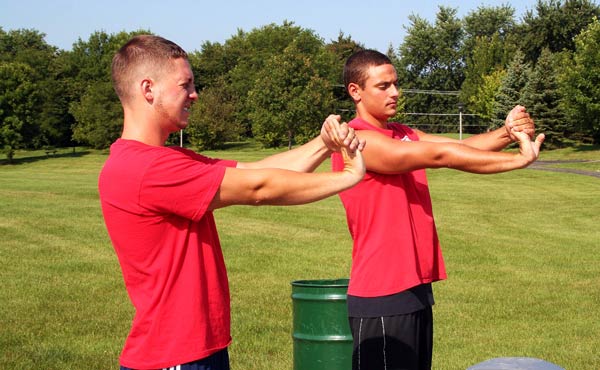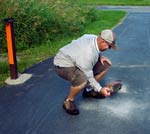
Planning a Safer Park CultureJust as every park worker knows it takes a lot of ongoing work to maintain “natural beauty,” every PDRMA member knows it also takes a lot of ongoing work to keep workers and workplaces safe to prevent avoidable injuries. Through the Loss Control Review (LCR), PDRMA staff works together with members to develop customized Plans of Action (POAs) that focus on areas for risk reduction based on actual agency losses and exposures. Even for something as basic as avoiding slips, trips and falls — a primary source of worker’s comp injuries — members can implement their POAs in different ways.
“People don’t realize how physical park maintenance work is,” says Scott Runkle, Risk Management and Special Facilities Manager at Skokie Park District, an Illinois Distinguished Park and Recreation Agency and winner of the National Gold Medal for Excellence in Park and Recreation Management. Skokie’s 42 parks cover more than 240 acres, with hundreds of year-round programs serving as many as half a million visitors a year. “The flowers look great, but someone has to dig the hole. Someone has to clean the pool and empty the trashcans. It doesn’t even have to be a very heavy activity to cause an injury if staff is not using proper body mechanics to protect themselves. On a ladder to fix a pipe, you might twist a certain way with your arms over your head. A wrench can be very heavy at that angle.” Or the simple activity of loading/unloading equipment from the back of a pick-up truck can place employees in awkward positions that increase the risk of injury.
When Runkle and his crew met with their PDRMA Risk Management Consultant to hammer out a POA based on their loss history, “we were on the alert for slips, trips and falls,” Runkle says. He found that implementing the POA required encouraging a culture shift to promote new behavior, from limbering up before starting job tasks to maintaining proper body form while working to doing site inspections. One surprisingly simple yet effective element: stretching every morning.
“Our POA included a stretching and calisthenics program for the parks maintenance staff to help them limber up. Two staff members lead the group of 40 workers in warm-ups,” he explains. “It helps avoid pulled hamstrings and back injuries since a lot of park maintenance requires plenty of repetition. Repairing park benches or emptying trash cans is heavy work, and if you go out there cold you can hurt yourself.”
Since starting the stretching program two years ago, Runkle reports Skokie does not have as many fatigue-related injuries. “If you have to lift 50 trays of flowers, each weighing 50 pounds, by the fiftieth tray you don’t have good form, and you can pull something. Stretching certainly helps.” The daily practice also makes staff more aware of having better form and performing their tasks more safely as a group…but a barbecue to celebrate every so often helps, too. “If after so many days — like 30 — we don’t have an accident, we’ll give them a breakfast or have a barbecue lunch,” he says.
  Runkle is open to other approaches to keep the slips, trips and falls to a minimum. For instance, sometimes a simple job site safety survey can help identify hazards and determine safe work practices prior to starting a task. “We can’t eliminate all risk, but we do our best to reduce injuries ongoing.” The newest approach he is considering draws on his expertise with lifeguard video audits. Runkle is open to other approaches to keep the slips, trips and falls to a minimum. For instance, sometimes a simple job site safety survey can help identify hazards and determine safe work practices prior to starting a task. “We can’t eliminate all risk, but we do our best to reduce injuries ongoing.” The newest approach he is considering draws on his expertise with lifeguard video audits.
“In the lifeguarding industry, we film the lifeguards as we put them through rescue drills, so we can observe them using proper form or point out areas they might be able to improve. I might try that with the maintenance staff — not a hidden camera, but a way to note best practices like securing a perimeter properly when using a tractor or showing proper dismount from equipment. For instance, we have staff as young as 18 or 22, and they like to jump off the tractor. We tell them if they want to work with us for 30 years, their knees are not going to be much good after 30 years of jumping.”
Visitors to the McHenry County Conservation District see open space (some 25,021 acres) with woodlands and wetlands, ponds and rivers, campsites and trails full of natural beauty. Behind the scenes, though, crews are busy clearing brush, trimming trees or operating heavy equipment…and thanks to more training — even going “back to school” — they know how to handle their jobs with fewer injuries.
“Our agency, along with many other PDRMA members, saw a rise in the number of incidents related to slips, trips and falls,” explains John Kremer, Director of Operations and Public Safety. “I look at this from two fronts; first, an injury inflicts pain and suffering on the individual, and I don’t want employees to be in pain. Second, when employees are out of work due to an injury, it is a hardship on them, their family and our agency. Again, no one wants this hardship.”
For McHenry’s POA, the countermeasures included stretching, training in 3 Points of Contact to make sure workers are stable on ladders or stairs, and the 30 Second Site Safety Walkthrough to ensure an area is clear of danger before starting a job. The Conservation District's Safety Committee analyzed a few departments to determine that slip, trip and fall hazards were the most prevalent cause of injuries and developed a POA to address this loss exposure.
“We knew the POA training (concepts) had entered the workplace when I heard the crews using the training phrases of ‘3 Points of Contact’ and ‘surveying the scene’ to tease each other on the job,” Kremer says. “It proved they heard the message and were holding each other accountable.”
This acceptance was all the more striking because of the staff’s initial reluctance to attend the training. “I know the staff viewed the concepts as common sense and thus the training as sort of silly,” says Kremer. However they soon got on board, with the help of Human Resources Manager Jenny Heider, MHRM, PHR, who led the staff (including seasonal workers) in a couple of different types of stretches.
“What I do is show PDRMA's on demand video on why and how to stretch, and then we practice some of the stretches from the video. When I tell people to stand up for stretches after the video, I get the ‘Oh, come on’ look, but as they do the stretches, their faces look more relaxed.”
One item in the POA sent the employees of two high-risk departments “back to school” for PDRMA training in back safety and ergonomics. “The Land and Facilities, and Natural Resources Departments, have very physical, labor-intensive jobs, with crews working in the field with heavy equipment,” Heider explains. “Initially, they thought it was going to be a ‘boring’ training session. But coming out, we got great reviews. Staff really liked it. Our district even paid for the same trainer to do a session for the other non-field staff. Our PDRMA Risk Management Consultant, Jackie Pierce, helped organized the training and was with us during all three sessions.
“I think the key to success was how the trainer related it to their jobs. After the training, the high-risk department employees split into small groups and did hands-on job tasks at different stations — raking, dealing with heavy trash cans, getting on and off a mower properly — and the trainer gave them advice on how to perform the task properly and more safely,” she says.
One additional benefit of going back to school, was the staff’s appreciation of PDRMA training. “Because of our largely rural locations, not everyone goes offsite to PDRMA trainings, but once they experience a training or special presentation like this, they understand PDRMA isn’t the ‘safety police’ making their lives more difficult with rules to follow; they actually care. It gives them a different perspective.” |

